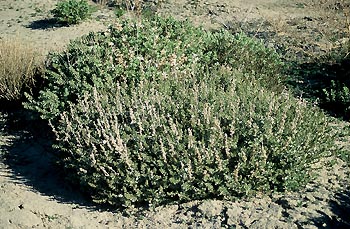Shadscale

Scientific Name:
Atriplex confertifolia (Torr. & Frem.) S. Wats.
Scientific Name Synonyms:
Atriplex collina Woot. & Standl.
Atriplex jonesii Standl.
Atriplex subconferta Rydb.
Symbol:
ATCO
Description:
Life Span: Perennial
Origin: Native
Season: Cool
Growth Characteristics: A dioecious shrub, growing 1 to 3 feet tall, densely branched, spiny, with a rounded crown. Within the Great Basin Desert, blooming season varies from late March in the southern portion of shadscale's range to about mid-June to the north. Fruits mature about 25 weeks after flowering and persist through winter. Shadscale reproduces entirely by seed.
Flowers/Inflorescence: Male flowers are terminal, dense, with leafy bracts below. Female flowers are solitary or clustered and found near the end of smaller branches, at the base of leaves. Both the male and female flowers are green and small. Flowers are wind pollinated, resulting in "fairly" successful seed production.
Fruits/Seeds: The fruit is a small utricle that typically bears 1 seed. Seeds are from 0.06 to 0.08 inch broad. The fruit is similar in appearance to the leaves and are yellowish-brown in color.
Leaves: Round, blunt, gray-green leaves, which are crowded in clusters. Margins are entire. Salty to the taste.
Stems: Twigs are rigid, and erect with spines extending above foliage. The twigs are yellow-brown and smooth. The trunk is irregular, appearing as a cluster of older branches. The bark is light to dark gray, somewhat scaly.
Ecological Adaptions:
Shadscale occurs in arid climates that receive 4 to 8 inches of precipitation annually. It occurs on dry slopes, flat areas, ridges, and valley bottoms, from 4000 to 7000 feet in elevation. It can form almost pure stands in some locations. It is resistant to overgrazing and is drought tolerant. Tolerance to drought is achieved through partial shedding of leaves; this reduces water loss during severe moisture stress. The spines of shadscale allow only 15 to 20% of the previous summers herbaceous growth to be grazed.
Shadscale growth is greatly related to seasonal precipitation. Shadscale is not fully deciduous, retaining the majority of its leaves through winter. A small proportion of leaves are shed in the fall, with new leaves produced in March or April.
Soils: Shadscale prefers well-drained, moderately saline soils where groundwater is below the rooting zone.
Associated Species: Big sagebrush, winterfat, blue grama, galleta grass, and greasewood.
Uses and Management:
Shadscale is used by all classes of livestock, as well as by mule deer, for forage. It is used mostly during winter and spring for browse. Late spring or summer grazing, especially if intensive, is injurious to shadscale. The fruits provide food for game birds and songbirds. The seeds of shadscale remain on the plant throughout the winter, enhancing its nutritional value.
Prolonged periods of high soil moisture are believed to increase shadscale's susceptibility to parasites and disease. Shadscale is very susceptible to water mold, root rot, and vascular wilt fungi.
American Indians ground the fruits of shadscale into flour.

